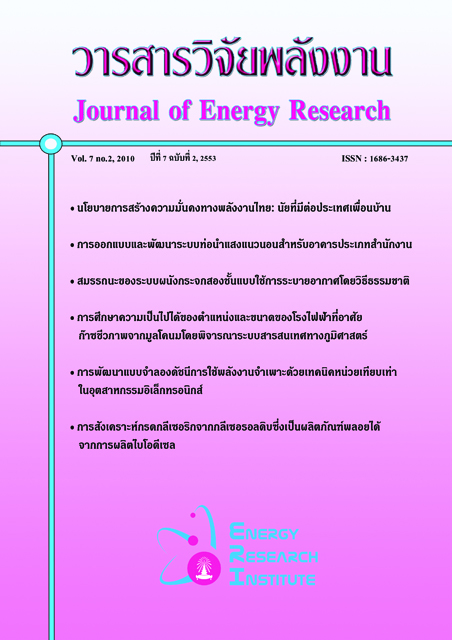การพัฒนาแบบจำลองดัชนีการใช้พลังงานจำเพาะ ด้วยเทคนิคหน่วยเทียบเท่า ในอุตสาหกรรมอิเล็กทรอนิกส์
Main Article Content
บทคัดย่อ
การศึกษาวิจัยเรื่องการพัฒนาแบบจำลองดัชนีการใช้พลังงานจำเพาะด้วยเทคนิคหน่วยเทียบเท่าในอุตสาหกรรมอิเล็กทรอนิกส์ เป็นการวิจัยเพื่อใช้เป็นแนวทางการใช้พลังงานมาตรฐาน (Benchmark) ในอุตสาหกรรมอิเล็กทรอนิกส์
โดยวิเคราะห์จากการใช้พลังงานต่อหน่วยผลผลิต (Specific Energy Consumption: SEC) ซึ่งหาได้จากการนำเอาค่าพลังงานไฟฟ้าที่ใช้ทั้งหมดหารด้วยปริมาณผลผลิตที่ได้และจากการที่โรงงงานแต่ละโรงมีผลิตภัณฑ์ที่หลากหลาย เนื่องจากผลิตภัณฑ์แต่ละชนิดอาจมีขนาดและความยากง่ายในการผลิตต่างกัน จึงต้องจัดหาวิธีในการปรับเทียบให้เป็นหน่วยเดียวกัน โดยนำเอาเทคนิคหน่วยเทียบเท่า (Equivalent Unit: EU) มาคำนวณหาปริมาณผลผลิตที่ได้ใหม่ ซึ่งมีการเปลี่ยนแปลงจากเดิมตั้งแต่ไม่ถึง 1% จนถึง 74%
จากนั้นจึงนำข้อมูลที่ได้มาทำแบบจำลองการใช้เกณฑ์ดัชนีชี้วัดการใช้พลังงาน โดยทำการรวมรวบตัวแปรที่ส่งผลต่อการใช้พลังงาน แล้ววิเคราะห์หาความสัมพันธ์ระหว่างตัวแปรต่างๆ ที่เกี่ยวข้องกับการใช้พลังงาน ด้วยวิธีการวิเคราะห์การถดถอยแบบพหุคูณ จากผลการศึกษาพบว่าตัวแปรหลักที่มีผลต่อการใช้พลังงาน คือ ชั่วโมงการทำงาน จำนวนของผลิตภัณฑ์ และผลต่างของอุณหภูมิ ซึ่งในการวิจัยครั้งนี้ได้พัฒนาแบบจำลอง โดยแบ่งผลิตภัณฑ์ออกเป็น 5 ผลิตภัณฑ์ คือ A, B, C, D และ E ทำให้ได้แบบจำลอง 5 สมการ ดังนี้ 1. พลังงานไฟฟ้า (kWh) = -1,175 + (0.094 x ผลิตภัณฑ์ A1) + (0.026xผลิตภัณฑ์ A2) + (0.00038 x ผลิตภัณฑ์ A3) + (0.0142 x ผลิตภัณฑ์ A4) + (0.0179 x ผลิตภัณฑ์ A5) , 2. พลังงานไฟฟ้า (kWh) = - 4,055 + (0.0848 x ผลิตภัณฑ์ B1) + (0.0518xผลิตภัณฑ์ B2) + (0.00907 x ผลิตภัณฑ์ B3) + (0.0603 x ผลิตภัณฑ์ B4), 3.พลังงานไฟฟ้า (kWh) = -3487, + (0.00916 x ผลิตภัณฑ์ C1) + (0.0358xผลิตภัณฑ์ C2) + (0.0382 x ผลิตภัณฑ์ C3), 4.พลังงานไฟฟ้า (kWh) = -1,849 +(0.0127 x ผลิตภัณฑ์ D1) + (0.00857xผลิตภัณฑ์ D2), 5.พลังงานไฟฟ้า (kWh) = -3,098 +(0.0179 x ผลิตภัณฑ์ E1) + (0.00568xผลิตภัณฑ์ E2)
A Model Development of Specific Energy Consumption by using equivalent unit technique in electronic industry
The purpose of this research is to develop a model for Specific Energy Consumption by using the equivalent unit technique in electronic industry. The research will be used as a guideline for consuming the energy (Benchmark) in an electronic industry.
To calculate Specific Energy Consumption is to use the energy consumption amount divided by quantity of product. The Fact that each factory has many varieties of products causes the difference of energy usages and the use of time, therefore the Specific Energy Consumption need to be more accurate. Also, the calculation of unit cost tends to be inaccurate due to the causes of different factors in the process of production. Therefore in the research the calculation of unit cost is made by the analysis of Specific Energy Consumption by using Equivalent Unit (EU) technique. The result from the research will bring about the new calculation of Specific Energy which changes only 1%to 74% from the past.
The information based on this model development of Specific Energy Consumption research has been collected from many electronic industries which focus on energy. The next thing is to analyze the relationship among variables of energy usage in electronic industries by the mean of multiple regressions. The result of the research found that main variables which affected the maximum energy consumption are the operation time, the number of product and the difference of temperature. In this research, the product models were developed into 5 types, which is A,B,C and D. the equitation of the models are 1. electric energy (kWh) = -1,175 + (0.094 x product A1) + (0.026x product A2) + (0.00038 x product A3) + (0.0142 x product A4) + (0.0179 x product A5) , 2.electric energy (kWh) = - 4,055 + (0.0848 x product B1) + (0.0518x product B2) + (0.00907 x product B3) + (0.0603 x product B4), 3. electric energy (kWh) = -3487, + (0.00916 x product C1) + (0.0358xผลิตภัณฑ์ C2) + (0.0382 x product C3) , 4 electric energy (kWh) = -1,849 +(0.0127 x ผลิตภัณฑ์ D1) + (0.00857x product D2), 5. electric energy (kWh) = -3,098 +(0.0179 x product E1) + (0.00568x product E2).

